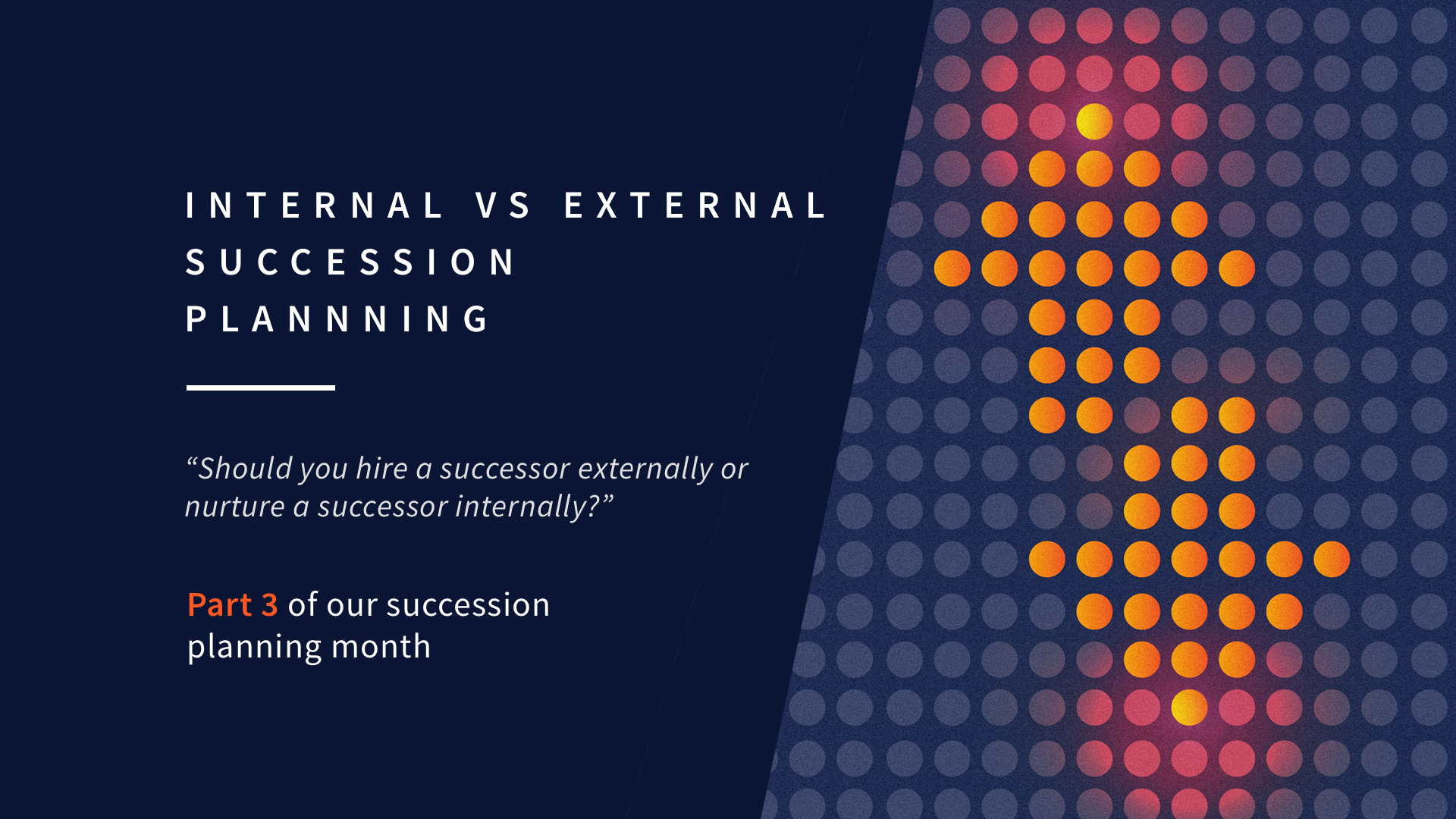Part 3 of our Succession Planning month, we look at whether you should hire externally or nurture someone internally in your succession planThis month we’re tackling the subject matter of succession planning, where we’ll be looking at what succession planning is, how to make a great succession plan, what happens when it all goes wrong and more. We continue the month by looking Internal vs External Succession Planning.
It’s important to have a solid succession plan in place to avoid potential risk caused by business-critical employees exiting the company. Yet an important question that arises is; ‘Should we hire a successor externally or nurture a successor internally?’.
It’s an interesting question that will vary depending on a variety of factors, from the cost of an external hire vs. internal, the downtime, training and whether they would be a right fit.
It’s not clean cut – Optimal productivity
£25,181 is the average cost to business of the downtime period between a business-critical employee leaving and their new successor (hired or promoted) reaching their optimal performance. according to a study by Oxford Economics, 2014.
This means that you’ll very rarely get a smooth transition no matter how perfect your succession plan is whether you internally or externally fill the position.
With optimal productivity being our benchmark, a filled position will always experience some amount of downtime, as the hire can never fully prepare for the entails of the job.
Time taken to get to optimal productivity varies largely depending on the background of the new employee and the sector in which they are coming from previously. If the employee is moving firms in the same sector the time of optimal productivity is greatly reduced than when compared to a student or someone who was previously unemployed.
Costs of Hiring
The costs of hiring a new employee varies based on a several factors. Studies have shown that the average cost of hiring a new employee is £5,433 (Oxford Economics, 2014). Factors affecting this can be anything from the sector the business is in, through to the type or level of employee that is being hired.
This means that there will always be a cost of bringing in someone fresh to fill the role. Whereas a promotion or pivot of an employee may save you some money in the short-term.
Another factor that has an impact on the cost of recruiting is the number of employees in the company. Companies with less than 9 employees spend on average £2902 on logistical costs, whereas firms with 250 or more employees spend on average over £7000. The difference in these costs comes down to smaller companies tending not to use temporary workers or recruitment agencies.
This will always depend on where you’re sitting financially at the time, if you’ve put in a succession plan to nurture a promising employee to move up to a new position for example a managerial position. Then training and preparation will pay off, downtime will be reduced and you’ll potentially increase loyalty with a promotion.
Some roles won’t be as replaceable, you’ll know through an effective development of a succession plan for that role. Roles like Financial Director or CEO may require the life experience and acumen of someone outside the industry.
The ‘right fit’
The importance of a hire being someone who is the ‘The right fit’ for your business is substantial. With a market where people consistently swap job roles and businesses experience high levels of churn it’s a priority that a business makes the right cultural fit, unless they quit within 6 months.
For an internal successor, this of course is not an issue as they are an already established employee who has been a part of the business for years, who know their business intimately; it’s goals, values, employees and best practice.
It’s important for a company to realise the importance of the culture and talent attraction of their business and keep a plan in place when it comes to building and maintaining it which is something we discussed in our talent article.
Not only is it vital to hire someone who is the right fit for the business but they also must be the right fit for the role, which is not always easy. Personality profiling can help with this as it will give a more in-depth overview of a person than interview questions alone.
Thomas International have a range of well-developed psychometric assessments which are easy to arrange with candidates for them to complete as part of the hiring process. Not only does this give an excellent view of the candidate, their abilities and their personality, but it also provides a benchmark for the individual that can be monitored and assessed as they progress through their career and the talent management programme.
Training Internal Talent
Building internal talent to be prepared to fill a business-critical position can still be expensive and time-consuming. Whether you send them on courses or hire an internal trainer, you’ll experience some high costs to get them ready for the role.
It’s important, in a succession plan, that you tally up these theoretical costs for both eventualities and look at what the outcomes of both choices could be. But remember if you create a great internal training course which could be semi-autonomous will make it transferable company wide.
Members of The Recruitment Network receive free and unlimited Sales, Leadership, Retainer and CX training for their consultants as part of their membership, to find out more about this see here.
We also offer a course for promising candidates that you believe will be able to thrive in middle management positions called Recruitment Trailblazers; we’ll take them through everything they need to know to become a great manager of people – find out more here.
Talent Management Programmes
Talent management programmes ensure that the right quantity and quality of people are in place within companies or organisations for the current and future business requirements and it is the ‘future’ part of that statement where succession planning comes in. Planning for the future with a talent management programme should link in with the business’s strategies, otherwise it is easy to lose sight of the main goals and destination.
Studies have shown that businesses that have talent management programmes in place post up to 15% higher earnings than those of their peers, so although these programmes develop employees and their skills there are benefits outside of this for the business as a whole.
Personality profiling, through the assessments that Thomas International offers for example, gives quantifiable data that can measured and analysed in order to assess how the employee is progressing through the programme but also how well the programme is doing in providing value to the employee.
While talent management programmes develop the individuals involved, there are some qualities that cannot be developed, so hiring the right person for the role is so important right from the start. No amount of development can make up for a poor fit for a role and it is good to keep this in mind when hiring and developing employees.
Employee Engagement
Losing an employee in a position that holds great worth to the company warrants the undoubtedly want to avoid a similar scenario when filling the role. Employee engagement is vital to avoiding churn.
Preventing disengagement of current employees helps to keep the company culture in a positive place. When the culture within a company works well then it also makes it easier to find talent, as current employees would recommend their workplace to a friend or acquaintance.
Using talent management programmes can help to retain employees too. More and more studies are showing that younger generations are more concerned with doing challenging and meaningful work than previous generations, so by having these programmes in place it can help employees chart their progression within the company, in the same way that involving employees in the process of producing a succession plan.
By involving the individuals that are included in the plan, it will receive their input and ideas which broadens the view and encourages collaboration. It will also mean that the employees involved with feel valued as an individual within the business and that the company doesn’t want to lose them, despite planning for their exit.
The aging workforce that are in place in businesses today can cause some frustration with the younger up and coming workers. A survey by CareerBuilder showed that 60% of over 60’s are postponing their retirement due to the economic climate, but most of these older workers are in higher positions in companies. As a result of this progression for the younger workers can get delayed, which means that they start to look to move companies rather than staying put. Involving these kinds of employees, both the older and the younger, up and coming, in planning for succession can help them to see that they are all appreciated and play a role in a bigger picture.
Conclusion
We believe if you’re weighing up one or the other you’re going to lose, it all depends on the role and the correct conditions required to fill that role. The whole point of a succession plan is to be prepared for theoretical scenario’s that will affect the business.
As we’ve seen, employees who are nurtured and developed will remain loyal and engaged. So it’s vital a succession plan includes strong training protocols to get your most promising employees ready to tackle a more advanced position, as it will make them feel like a valued part of the company.
But it’s always a good idea to keep a plan of action in place to externally recruit a candidate for your business-critical employee role, especially when you’ve struggled to locate a internal candidate who will fully fit into the role.
When to externally recruit:
- Have a great candidate already in mind who can fill in quickly.
- You have a tight deadline for filling the position.
- When the stability of the internal structure is delicate and shifting employees make cause trouble.
- There still isn’t a strong succession plan in place yet, and time constraints make it difficult to create one quickly.
- The required skills/experience required to take the role are not available/teachable internally.
- It’s important to bring a fresh perspective into the role.
- You’ve got a good training plan in place to onboard the new hire.
When to internally recruit:
- Promising employees in the company who could fill the job.
- Good lead time / notice, which you’re able to promote.
- Your company is thriving and internal shifts are viable, employee surplus.
- An abundance of skills and experience for the role with internal talent
- Lack of onboarding training to bring an external hire to optimal performance efficiently
Every job role will be different and every company’s situation will be varied, so there is no one-way to effectively fill a role. So when it comes to internal versus external we say do both, be prepared and build a solid succession plan for each business-critical role. Read the other entries of our succession planning month to get to know more about what a succession plan is and how to create a great succession plan.
Share :



